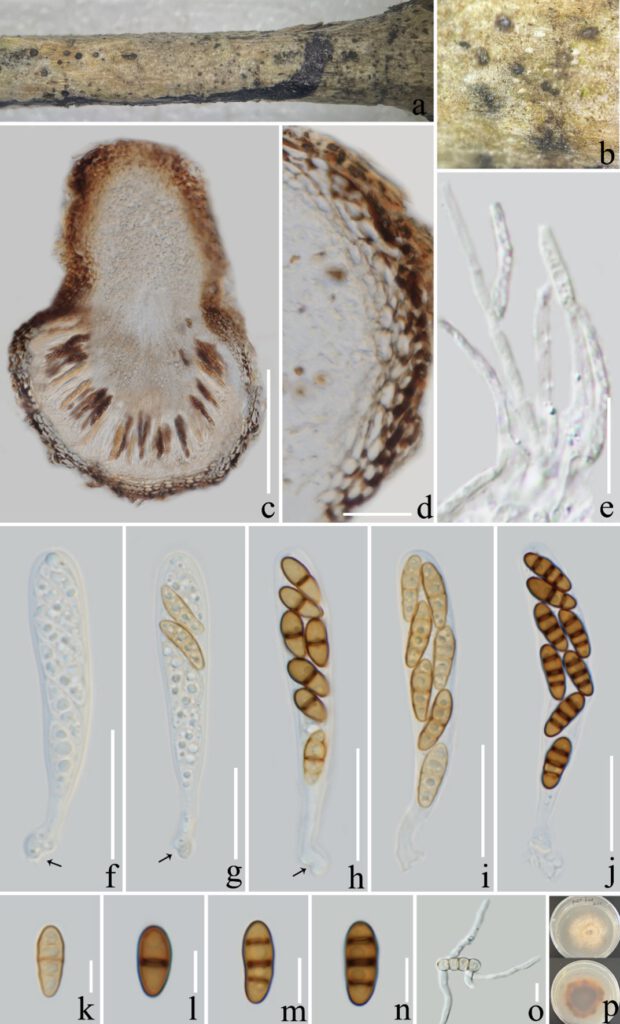Pseudocoleophoma puerensis L. Lu, K.D. Hyde & Tibpromma, sp. nov. (Figure 2)
MycoBank number: MB; Index Fungorum number: IF; Facesoffungi number: FoF 12761;
Etymology: Name reflects the location Pu’er city in Yunnan Province, where the holotype was collected.
Holotype: ZHKU 22-0118
Saprobic on decaying branch of Coffea arabica var. catimor. Ascomata 150–300 high × 170–220 μm wide (x̅ = 197 × 199 μm, n = 15) (includes ostiolar neck), solitary, immersed to erumpent, brown to black, globose or subglobose. Peridium 14–20 μm wide (x̅ = 17 μm, n = 20), thin, wall composed of 2–4 layers textura angularis cells, brown to dark brown. Hermathecium 1.5–3 µm wide (x̅ = 2.3 μm, n = 20) septate, branched, numerous, hyaline, pseudoparaphyses. Asci 50–70 × 7–11 μm (x̅ = 57 × 8.5 μm, n = 20), 8-spored, fissitunicate, cylindrical, rounded at the apex, with a shallow ocular chamber, long-stalked with club-like pedicel. Ascospores 10–15 × 3.5–6 μm (x̅ = 11.6 × 4, n = 20), uni to biseritate, narrowly ellipsoid or oblong, 1–3 thick and dark eusepta, slightly constricted at septa, straight or slightly curved, hyaline and yellowish brown when young, turning brown when maturation, normally 4 guttulate, without sheath. Asexual morph: Not observed.
Culture characteristics: Colonies on PDA after two months attaining a diam of 30 mm at 20 °C, above side pale-yellow, circular, flatted, margin filamentous, reverse side center brown, middle off yellowish brown and white at the margin.
Material examined: China, Yunnan Province, Pu’er city, on decaying branch of Coffea arabica var. catimor, (100°56’9” E, 22°40’28” N, 1090.5 m), 16 September 2021, LiLu, Pu’er 3-2 (ZHKU 22-0118, holotype), ZHKUCC 22-0204 = ZHKUCC 22-0205. GenBank number; ITS: ***, LSU: ***, SSU: ***, tef1-α: *** (ZHKUCC 22-0204, ex-type); ITS: ***, LSU: ***, SSU: ***, tef1-α: *** (ZHKUCC 22-0205).
Notes: In the phylogenetic tree constructed based on multigene data, our isolates clustered within Pseudocoleophoma and formed a distinct branch basal of Pse. typhicola (MFLUCC 16-0123), with a fairly good statistical support (60% ML/1.00 BYPP, Figure 1). Based on nucleotide comparisons, our isolate (ZHKUCC 22-0204) differs from Pse. typhicola (MFLUCC 16-0123) by 63/533 bp (11%) in ITS, 18/669 bp (2.6%) in LSU, while it lacks the SSU and tef1-α genes. The morphology of our isolate is similar to Pseudocoleophoma which was described by Tanaka et al. [43], although we noticed that the ascospores are 1–3 septate, brown, and no sheath in ascospores. Therefore, herein we introduce Pse. puerensis as a new species in Pseudocoleophoma.

Figure 2. Pseudocoleophoma puerensis (ZHKU 22-0118). (a–b) Ascomata on decayed branch of Coffea arabica; (c) Section of an ascoma; (d) Peridium at side; (e) Pseudoparaphyses; (f–j) Immature and mature asci, arrows indicate club-like pedicel; (k–n) Ascospores; (o) Germinated ascospore; (p,q) Colony on PDA. Scale bars: (c,e) = 100 µm; (f–j) = 20 µm; (k–n) = 5 µm; (o) = 10 µm.
